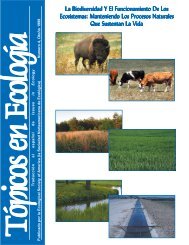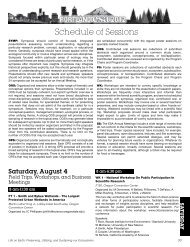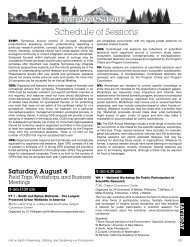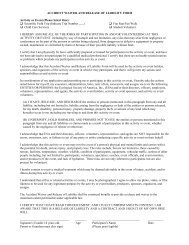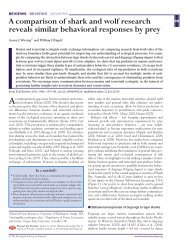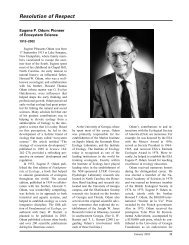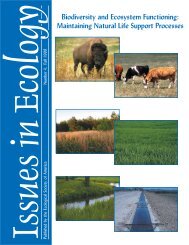here - Ecological Society of America
here - Ecological Society of America
here - Ecological Society of America
Create successful ePaper yourself
Turn your PDF publications into a flip-book with our unique Google optimized e-Paper software.
Abstracts and Speaker Biographies<br />
Service Director and provides leadership on science policy<br />
and scientific applications in resource management. Born<br />
and raised in Mexico City, she has a Bachelor <strong>of</strong> Science<br />
degree in biology from the National University <strong>of</strong> Mexico, and<br />
a Masters and Ph.D. in Organismic and Evolutionary Biology<br />
from Harvard University. Her research focused on the<br />
systematics, behavior, and biogeography <strong>of</strong> Neotropical<br />
bumble bees. Before coming to the Service, Chavarria<br />
worked for the Natural Resources Defense Council,<br />
Defenders <strong>of</strong> Wildlife, National Wildlife Federation, and the<br />
National Fish and Wildlife Foundation.<br />
The impact <strong>of</strong> introduced plants on food webs in<br />
managed ecosystems<br />
Douglas W. Tallamy, University <strong>of</strong> Delaware<br />
Karin Burghardt, Yale University<br />
Managed landscapes in which introduced ornamental plants<br />
are favored over native plant communities now dominate the<br />
suburban/urban matrix in the United States. Many such<br />
ornamentals have escaped cultivation and have displaced<br />
native shrub species in “natural areas.” Thus, the first trophic<br />
level is now commonly a novel mixture <strong>of</strong> plant species with<br />
no shared evolutionary history. We have used literature host<br />
records and controlled feeding trials, as well as common<br />
garden experiments, unmanipulated invasions <strong>of</strong> natural<br />
areas, and manipulated plantings in suburban neighborhoods<br />
to measure the impact <strong>of</strong> introduced plants on insect<br />
herbivores and the insectivores that eat them. We have found<br />
that native plants are recorded as host plants for up to 15fold<br />
more species <strong>of</strong> Lepidoptera than are introduced plants.<br />
In common garden comparisons, native plants that were<br />
congeners <strong>of</strong> introduced species supported 50% more<br />
caterpillar species and abundance, w<strong>here</strong>as native plants<br />
that were not closely related to introduced plants supported<br />
75% more caterpillars and caterpillar species. Specialists<br />
were five times less abundant on introduced plants and, to<br />
our surprise, generalist abundance and richness was<br />
reduced by over 50%. Moreover, invaded hedgerows<br />
supported 22 times fewer caterpillars and five times fewer<br />
caterpillar species than uninvaded hedgerows in Maryland,<br />
Pennsylvania, and Delaware. In view <strong>of</strong> the critical role that<br />
caterpillars play in supplying North <strong>America</strong>n birds with<br />
essential carotenoids, lipids, and protein during reproduction,<br />
an understanding <strong>of</strong> how introduced plants reduce<br />
Lepidoptera availability should inform future restoration and<br />
stewardship practices in both urban and natural landscapes.<br />
Douglas Tallamy is Pr<strong>of</strong>essor and Chair <strong>of</strong> the<br />
Department <strong>of</strong> Entomology and Wildlife Ecology and director<br />
24 Developing <strong>Ecological</strong>ly-Based Conservation Targets Under Global Change<br />
<strong>of</strong> the Center for Managed Ecosystems at the University <strong>of</strong><br />
Delaware in Newark, Delaware, w<strong>here</strong> he has authored 73<br />
research articles and has taught Insect Taxonomy, Behavioral<br />
Ecology, and other courses for 31 years. He received his B.S.<br />
in Biology at Allegheny College, his M.S. in Entomology at<br />
Rutgers University, his Ph.D. in Entomology at the University<br />
<strong>of</strong> Maryland, and his Post Doctoral experience at the<br />
University <strong>of</strong> Iowa. His current research goal is to better<br />
understand the many ways insects interact with plants <strong>of</strong><br />
different evolutionary origins and how such interactions<br />
determine the diversity and richness <strong>of</strong> animal communities.<br />
Tweak, adapt, or transform: How to build a<br />
resilient future for agriculture<br />
Lisa A. Schulte Moore, Iowa State University<br />
Conservation <strong>of</strong> ecosystem services in agricultural regions<br />
worldwide is foundational to, but <strong>of</strong>ten perceived to be in<br />
competition with, other societal outcomes, including food<br />
and energy production and thriving rural communities.<br />
Perhaps now<strong>here</strong> is this clearer than the U.S. Corn Belt,<br />
which garners phenomenal agricultural productivity for<br />
human benefit while sacrificing topsoil, water quality, flood<br />
control, and native biodiversity. I will discuss the results <strong>of</strong> my<br />
social-ecological research on the strategic integration <strong>of</strong><br />
perennial vegetation over landscapes and watersheds as a<br />
win-win solution for maintaining agricultural productivity,<br />
achieving substantial gains in environmental benefits, and<br />
expanding rural populations and vitality.<br />
Lisa Schulte Moore is an associate pr<strong>of</strong>essor <strong>of</strong> natural<br />
resource ecology and management at Iowa State University.<br />
Her research focuses on the causes, consequences, and<br />
design <strong>of</strong> landscape and land-use change, and spans from<br />
plot-scale ecological experiments to regional-scale social<br />
assessments. Focal ecosystems include forests <strong>of</strong> upper<br />
Midwest and agroecosystems <strong>of</strong> the U.S. Corn Belt. She<br />
teaches undergraduate and graduate courses in ecology,<br />
forestry, and wildlife biology.<br />
The power <strong>of</strong> the crowd: Socially networked citizen<br />
science as an integrative tool for emergent<br />
conservation research and management<br />
Janis L. Dickinson, Cornell University<br />
Citizen science has become an increasingly important tool for<br />
large-scale ecological research, education, and outreach<br />
since the advent <strong>of</strong> the Internet. Today the Cornell Lab<br />
engages a large public to collect and enter data over the



